
Steamboat Waybills, page 10
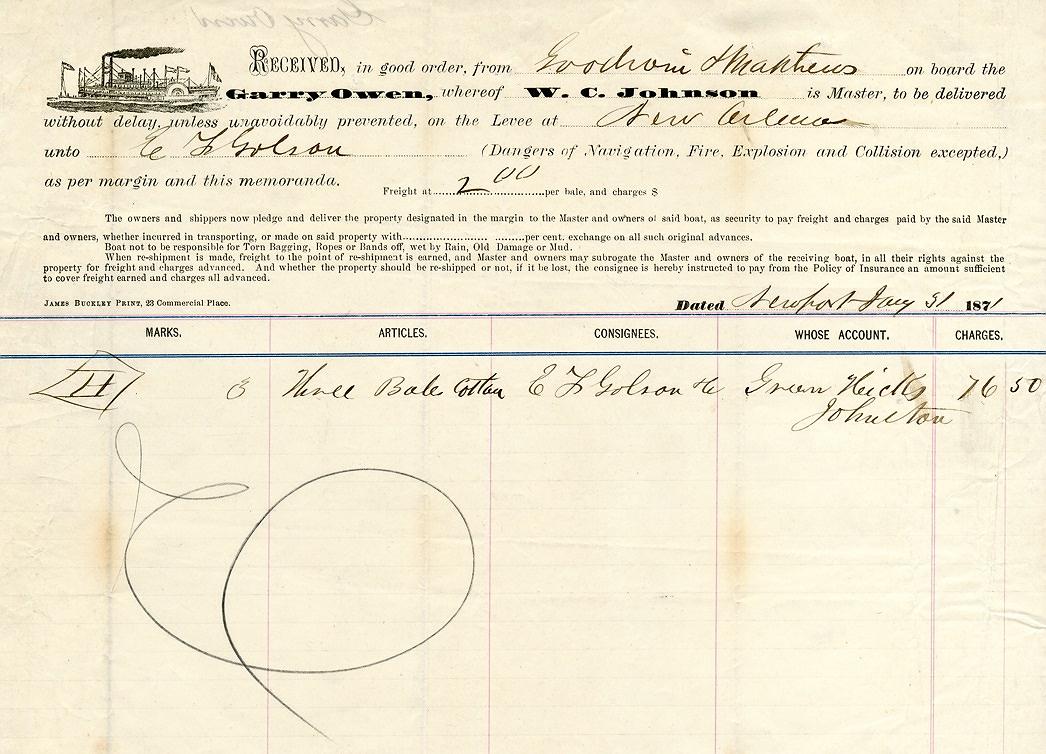
Waybill for 3 bales of cotton at New Orleans, month and day are illegible but the year was 1871. See name origin from the familiar Irish "air" that became associated with the U.S. cavalry and General Custer.
GARRY OWEN sternwheel packet
Way's Packet Directory 2204
Built at Wheeling, West Virginia in 1870.
131 x 32.5 x 4.4.
First master, Capt. J .W. Carlton of New Orleans who owned a share along with Charles B. Harrington and Nick Benchman, also of New Orleans.
Ran New Orleans-Ouachita River, and in 1873 was at Alexandria, La., on Red River.
Reported sunk by a tug at New Orleans, Feb. 4, 1876.
Garryowen
Traditional Irish Songs
lyrics.tandj.net
[Garryowen is known to have been used by Irish regiments as a drinking song. The name is derived from Gaelic meaning Owen's garden, and is nowadays part of Limerick city. That was where the 5th Royal Irish Lancers made their home, and soon the song became associated with the Lancers' drinking. The Irish poet Thomas Moore wrote the words around 1807. The tune is first documented as Auld Bessy in 1788.
General George Armstrong Custer reportedly heard the song among his Irish troops and liked it. Lieutenant Colonel (Captain) Myles W. Keogh and several other officers with ties to the Fifth Royal Irish Lancers and the Papal Guard, two Irish regiments in the British Army, were believed to be instrumental in bringing the air to the regiment. The tune was then played so often the 7th Cavalry became tied to it. In 1867 it was adopted as the official marching song of the Seventh Cavalry. It was the last song played for Custer's men as they left general Alfred Terry's column at the Powder River and rode into history by being defeated by the warriors of the Lakota, Cheyenne and Arapaho nations on the morning of 25th June 1876 at the Battle of Little Bighorn]
Last two stanzas of the Thomas Morre lyrics:
Johnny Connell's tall and straight
And in his limbs he is complete
He'll pitch a bar of any weight
From Garryowen to Thomondgate
Garryowen is gone to rack
Since Johnny Connell went to Cork
Though Darby O'Brien leapt over the dock
In spite of judge and jury
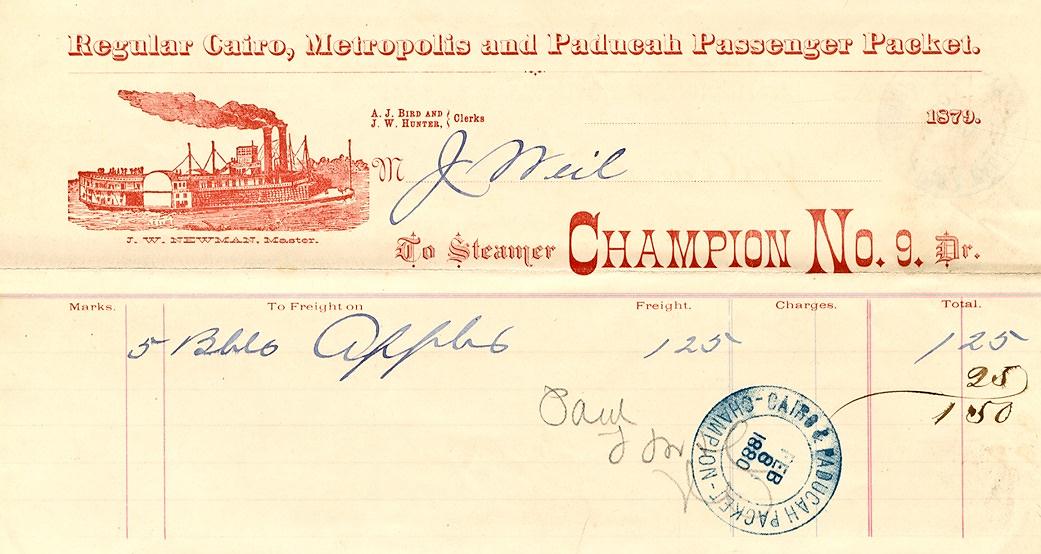
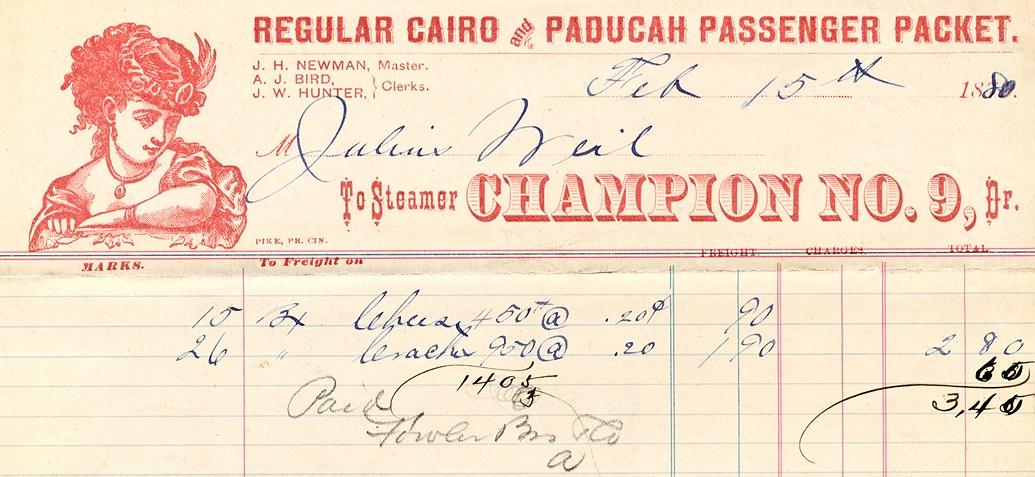
2 nice waybills from the CHAMPION No. 9 with interesting vignettes: '79 with a steamboat, '80 with a well upholstered lady
CHAMPION No. 9 sidewheel packet
Way's Packet Directory Number 0933
Built at Cincinnati, Oh., 1875.
462.79 tons. 202.4 x 36.4 x 5.2.
Owned by the Shinkle family.
She frequently carried baseball crowds from the foot of Walnut Street in Cincinnati to the East End where the field was located near what later was the Cincinnati Gym property.
In the latter 1870s she ran competition for a time with the JAMES FISKE JR., in the Paducah-Cairo trade and lost out.
Her owner at the time was a Mr. Byrd who joined forces with circus man Dan Rice.
They transformed this sidewheeler into a showboat and toured the South with it.
She was still listed in 1886.
Note: CHAMPION No's. 7 and 8 were both towboats.
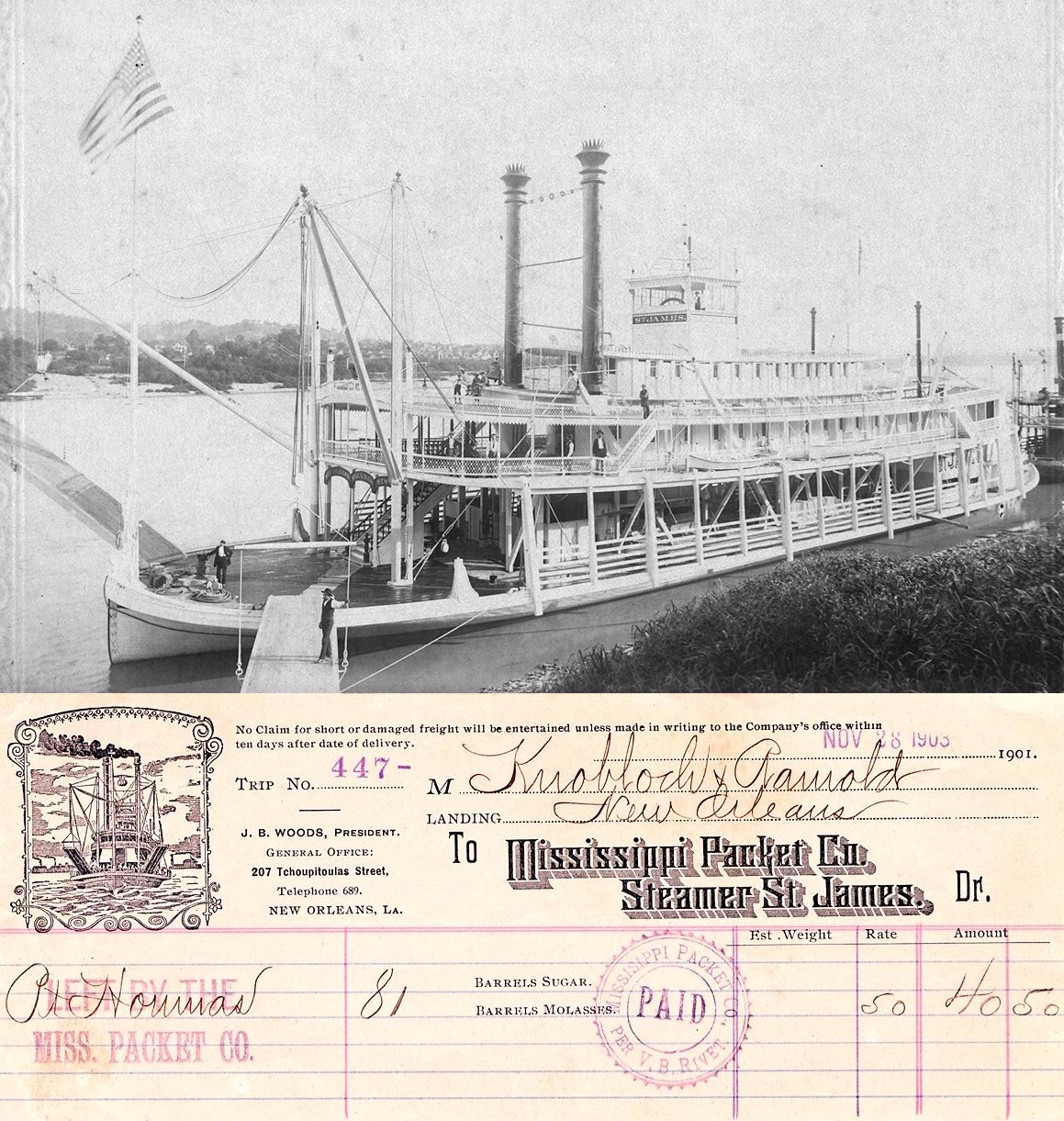
Waybill dated 28 November 1903
ST. JAMES = sternwheel packet & excursion boat (1898-1916)
Way's Packet Directory Number 4936
Built in 1898 at Cincinnati, Ohio
Under the ownership of Merchants & Planters Packet Company she ran tri-weekly New Orleans-Baton Rouge. Under ownership of Mississippi Packet Company, she ran New Orleans-Bayou Sara semi-weekly. John F. Klein ran her on excursion at St. Louis in 1914, then ran excursions at Pittsburgh and the upper Ohio in 1915.
She departed Pittsburgh on a one-way Mardi Gras trip and burned soon after her arrival at New Orleans on March 20, 1916
Owners:
1898 Merchants & Planters Packet Company; Mississippi Packet Company; Captain W.A. Duke
1914 John F. Klein
1916 People's Packet Company
Officers:
1905: E.R. Daigre (pilot)
1914: Captain Frank Gill (master)
Elmer Good (pilot)
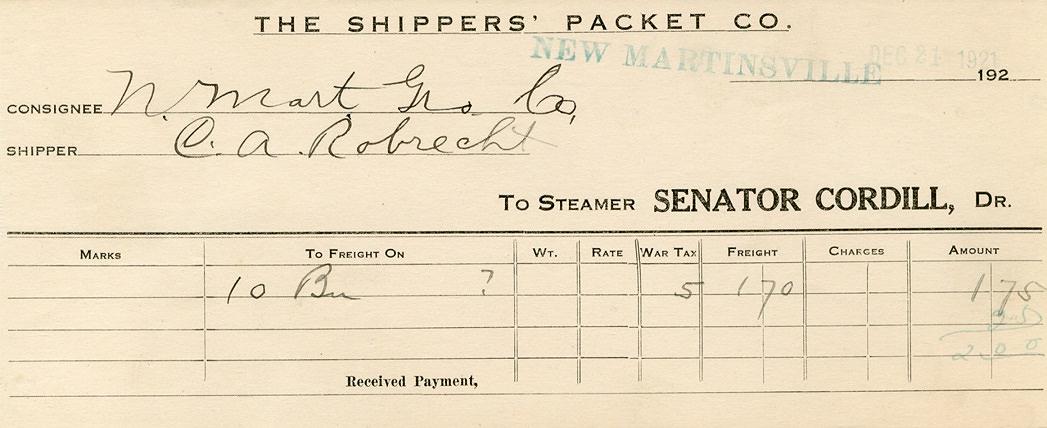
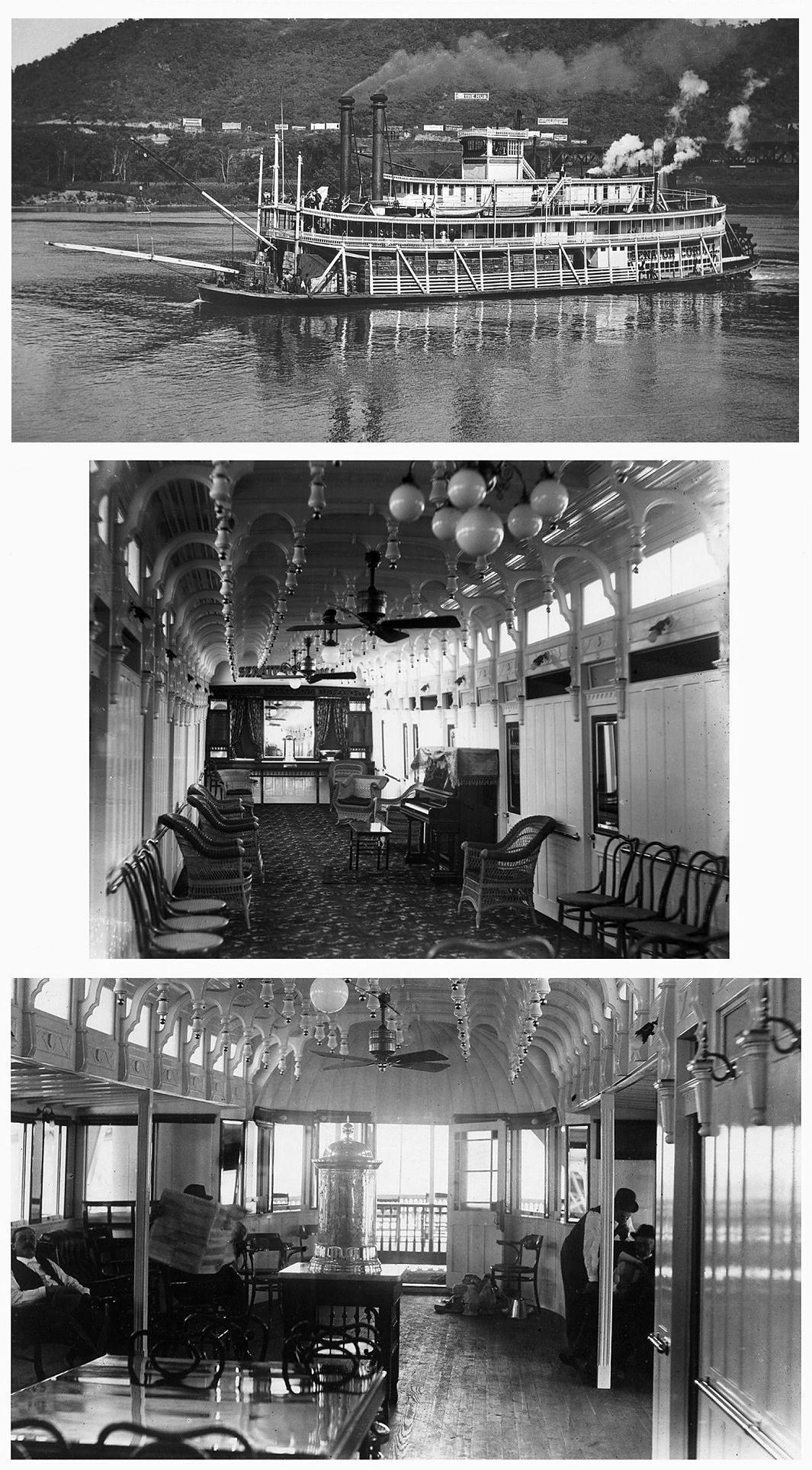
These photos of the SENATOR CORDILL are beautiful not only as photos but the boat herself was so curvaceous on the outside and inviting on the inside.The interior surfaces shine and the ambiance/atmosphere is enthralling, in these pictures the cabin looks like you could walk into it, the depth and detail is seemingly three dimensional. Truly remarkable. All 3 are Murphy Library treasures.
Photos Courtesy of Murphy Library at the University of Wisconsin - La Crosse
Steamboat Collection Photographs
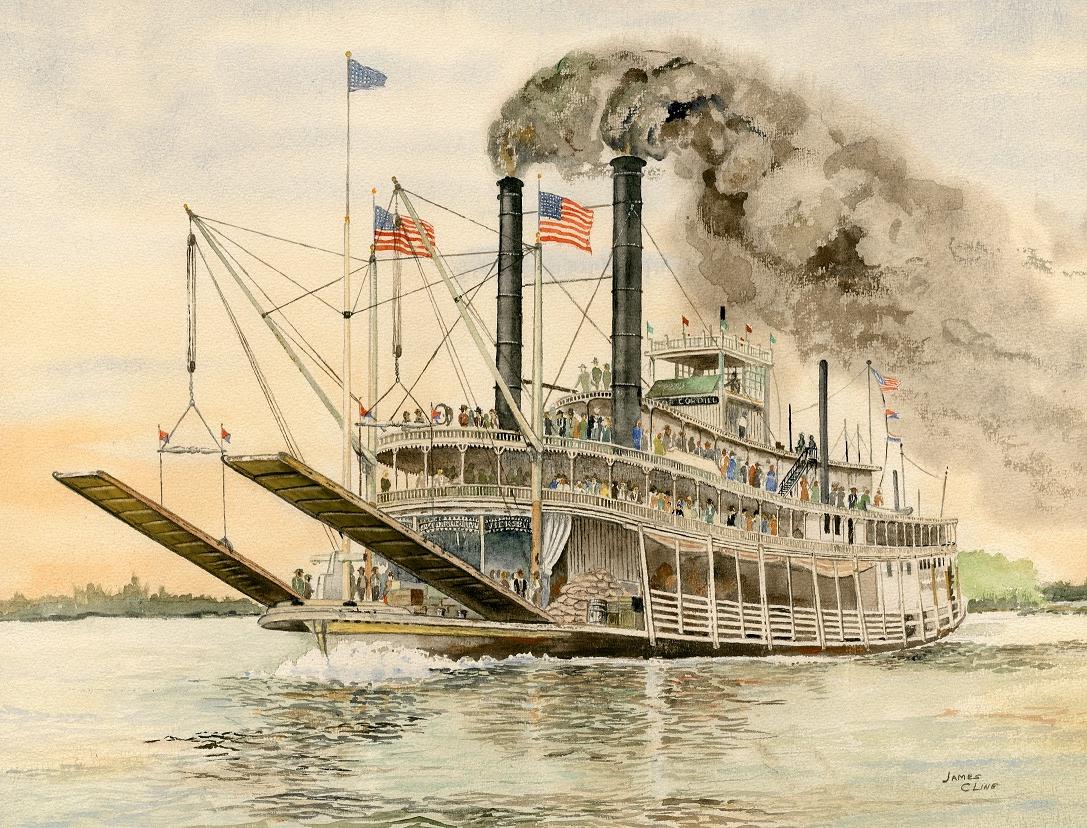
Iowa watercolorist James Cline's undated painting of the SENATOR CORDILL. Image area seen here in rotated cropped format approximately 16 x 20 inches.
Fred Way summed her up the SENATOR CORDILL (number 5050) in his Packet Directory:
"In memory of this big lady, let it be said this scribe (who was master-pilot on her three months in 1931, and pilot in 1932, '33 and '34) she was the most comfortable and satisfactory pile of lumber to pilot that I know about. In high wind she was as deliberate as a turtle. She had pretty engine room bells, a most wonderful whistle - she was one of the very few steamboats I really anticipated coming on watch on, day or night, rain or shine.
There is a complete story of the SENATOR CORDILL with many photographs in S&D Reflector, March 1971 issue, pages 13 - 25.
SENATOR CORDILL Sternwheel packet (1902-1934)
Way's Packet Directory Number 5080
Built in 1902 at Jeffersonville, Indiana by Howard Ship Yard
Original price: $28,950.
She was a stately looking steamboat with double swinging stages.
In the beginning she ran Vicksburg-Natchez tri-weekly and also handled U.S. mail.
On January 27, 1903 she participated in a parade and celebration when the Yazoo River diversion put Vicksburg back on the map.
In 1912 her engines were replaced by compound non-condensing engines and she was lengthened in 1925 at Point Pleasant, West Virginia.
In March 1918 she sank near Vicksburg and was raised by Captain George Wilson.
In July 1920 she was sold to a group of upper Ohio River produce dealers and entered the Pittsburgh-Charleston trade.
She tended to be accident prone:
sank in the Siegrist Riffle
sank in the Kanawha River above Lock 7 after hitting a log
stranded on Elk Chute Bar on the Kanawha from March 12-April 2, 1927
broke her wheel shaft on the Kanawha River in June 1927
exploded the main throttle valve at Point Pleasant, West Virginia on March 2, 1928, killing her engineers struck a rock and sank below Lock 18 on the Ohio River in October 1930
In 1929 she teamed up with the QUEEN CITY and ran in the Pittsburgh-Cincinnati trade at various times until 1933.
Captain Fred Hornbrook then ran her under lease in the Pittsburg-Cincinnati trade until she sank after hitting an improperly lowered wicket at Dam 14 on the Ohio River above Clarington on February 5, 1934. Three deckhands were lost.
U.S. Engineers raised her and towed her to Marietta.
She was then sold to Charles Zubik who towed her to Pittsburgh and dismantled her
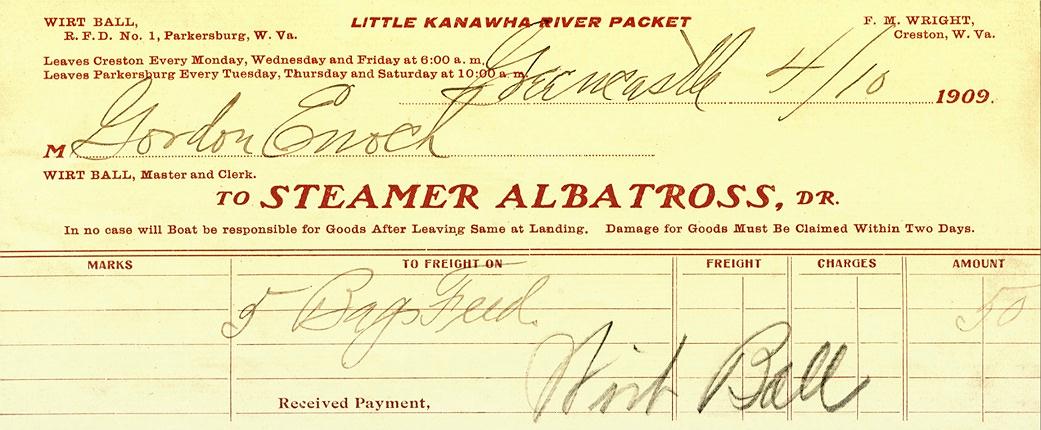
Two steamboats called ALBATROSS are represented in the La Crosse collection. One was a huge railroad transport sidewheeler and the other a small sidewheeler that plied the Fox River.
I have not been able to locate any history regarding the Little Kanawha River steamer ALBATROSS that originated this waybill on April 10, 1909 but a clue was provided in an online article by Norma Knotts Shaffer about the history of navigation on the Little Kanawha in West Virginia:
"In the late nineteenth century a series of locks were built in Wood and Wirt Counties, creating 'slack water' for steamboat traffic up the river as far as Creston."
So it seems likely that the ALBATROSS only operated as far up river as Creston, West Virginia.
Shaffer tells us of the development of navigation beyond Creston, using shallow draft gas boats:
"Around the turn of the century, Norm Williams, devised a new type of watercraft which was used for several decades to provide transportation on the Little Kanawha above Creston. In 1897, Mr. Williams, a Calhoun County native, purchased a bateau that had been used to transport freight up the West Fork of the Little Kanawha as far as Richardson. The new watercraft was built on the bateau which was later sunk, thus permitting the new craft, the first gasoline powered boat, to be floated.
This gas boat was powered by a four-horsepower stationary type engine located in the center of the boat. It was propelled forward and backward by looping two belts over a pulley with the belts running to the stern of the boat and across two idler pulleys thereby turning the paddlewheel. One of the belts had a half-turn in it, and the other was straight. By shifting the straight belt to an idle pulley attached to the paddle wheel by a chain, the boat could be made to move backward. When the belt with the half-turn was shifted to the idle pulley, the boat would move forward. Since this small light-weight craft required much less water depth, it was now possible to navigate the upper reaches of the Little Kanawha.
Today it seems impossible that navigation existed upriver as far as Burnsville, or on the waters of Steer Creek as far as Lockney. However, it was only possible to reach the upper reaches of these streams during one of the many "mud rises" which occurred frequently, particularly during winter and spring. Goods were stored along the riverbanks and when the "rise" occurred, gasboats from downriver arrived upriver with imported goods, and the goods for export were loaded and transported downriver. With the introduction of the gasboat, the Little Kanawha became a busy commercial highway for the area above Creston. The lumber and petroleum industries flourished during this period.
Timber and wood products such as cross ties and barrel staves were exported via the river, equipment and pipe for the booming oil and gas industry were transported into the area, and carbon black, one of the area's primary products was transported out. Grantsville became the boat-building center of the Little Kanawha Valley and the area prospered during the riverboat era. Not only did the river serve as a commercial highway, it also served the citizens of the area as a means of public transportation. The trip to Parkersburg was a day-long journey, and it is not uncommon, even today, to find Calhoun County residents who remember riding a gas boat to Parkersburg. During World War I, men leaving to serve their country in the military were transported via a gas boat, and the boats also performed the service of delivering mail for the U. S. government. Many college students caught their first glimpse of Glenville Normal School from the deck of a gasboat.
With the coming of paved highways during the late 1920's and early 1930's, the use of the river as a mode of transportation declined and today it is difficult to imagine our river as having been anything other than the stream we know today."
The full text of Shaffer's article can be found here:
freepages.rootsweb.ancestry.com
WEST VIRGINIA'S BEST KEPT SECRET
Calhoun County's Little Kanawha River Valley
By Norma Knotts Shaffer
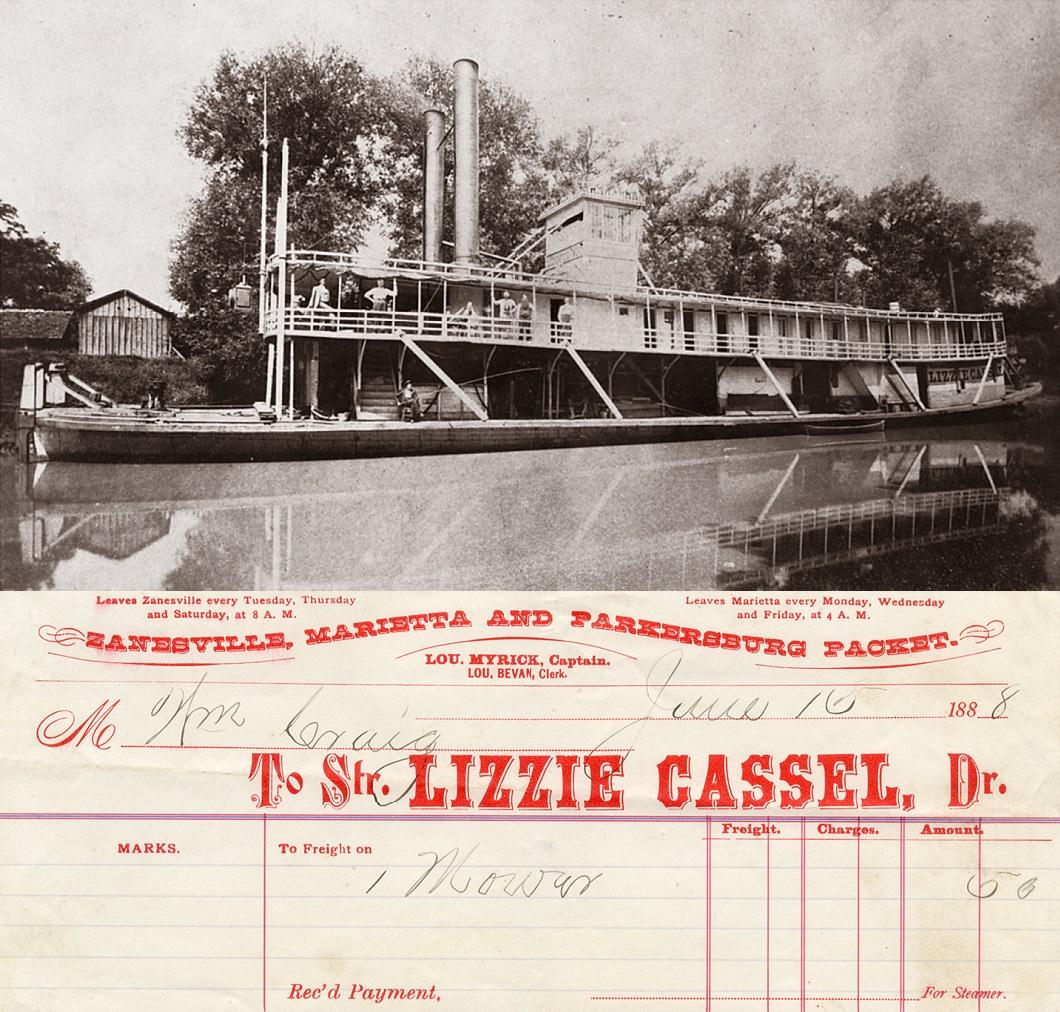
LIZZIE CASSEL
Sternwheel packet
Way's Packet Directory Number 3533;
Her hull was built in 1873 at Marietta, Ohio and construction completed at McConnelsville, Ohio. Her engines came from the J.H. BEST.
She began in the McConnelsville-Zanesville trade in December 1873 but soon changed to Parkersburg-Zanesville.
This waybill was filled out on June 15, 1888.
She carried the U.S. mail until 1889.
On June 12, 1886, she hit an obstruction on the Muskingum River (8 miles downstream from Zanesville), knocked a hole in the hull and sank but was raised.
After she sank for the final time in July 1895 at Zanesville, Ohio, she was sold for junk for $20.
Her machinery went to the Hazel Rice.
Her whistle was cast by a Beverly foundry in 1873 and has been in the Ohio River Museum at Marietta, Ohio
Another fine musical-sounding lady's name for a steamboat.
Photo Courtesy of Murphy Library at the University of Wisconsin - La Crosse Steamboat Collection Photographs.

With the exception of images credited to public institutions,
everything on this page is from a private collection.
Please contact Steamboats.com for permission for commercial use.*
All captions provided by Dave Thomson, Steamboats.com primary contributor and historian.
